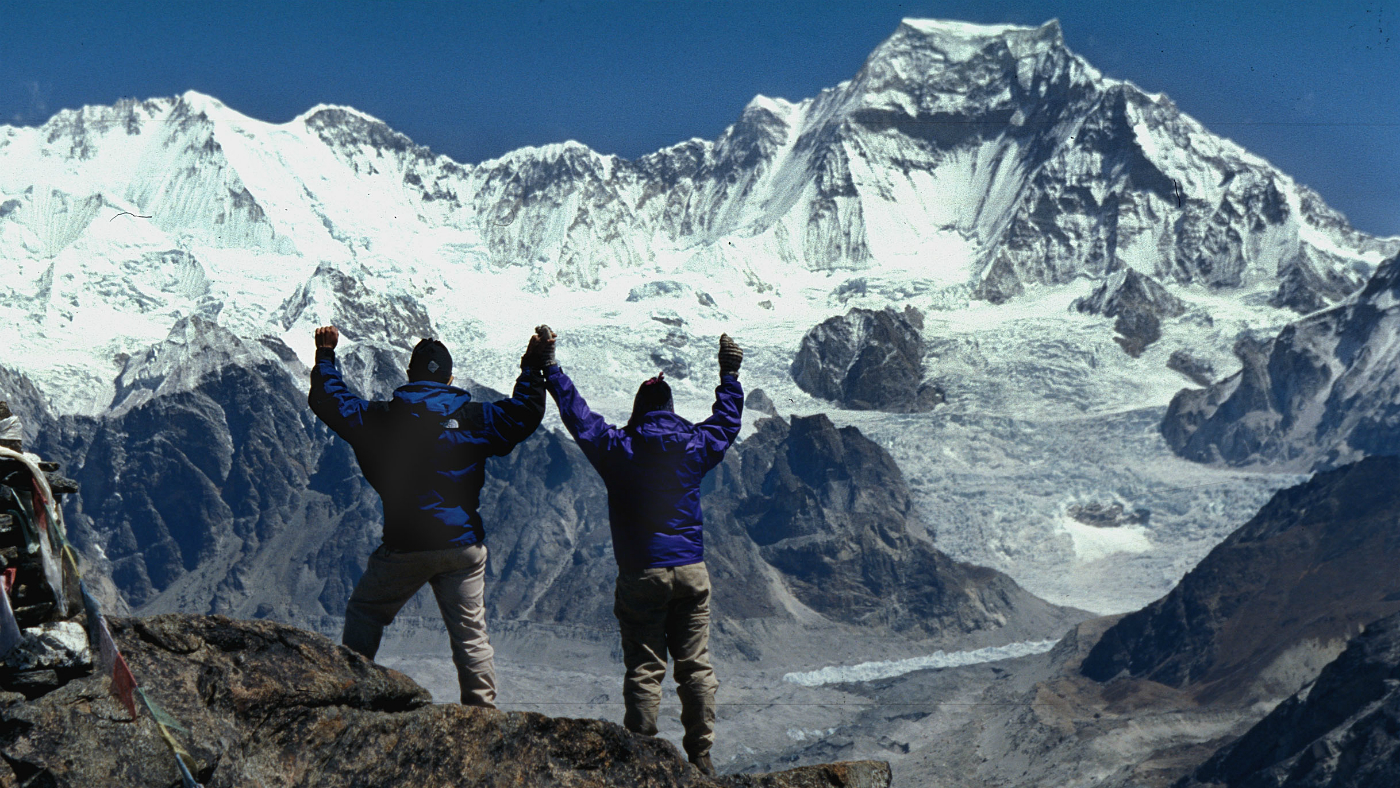How dangerous is Mount Everest?
Nepalese authorities hand out record number of climbing permits, prompting fears of ‘cataclysmic’ overcrowding

Guides and workers at Mount Everest are preparing for what may be the busiest ever climbing season on the world’s tallest mountain.
According to NDTV, more than 4,000 climbers have reached the top of Everest since the mountain was first summited by New Zealand mountaineer Edmund Hillary and his guide Tenzing Norgay.
However, the Indian broadcaster adds that “recent years have seen especially rapid growth” in the number of people attempting to scale the peak, which remains one of the deadliest in the world.
The Week
Escape your echo chamber. Get the facts behind the news, plus analysis from multiple perspectives.

Sign up for The Week's Free Newsletters
From our morning news briefing to a weekly Good News Newsletter, get the best of The Week delivered directly to your inbox.
From our morning news briefing to a weekly Good News Newsletter, get the best of The Week delivered directly to your inbox.
The climbing season has already started in Nepal and the authorities have handed out a record 375 permits to climbers.
Although climbing Everest is far safer than it once was, the sheer number of climbers scaling the peak each year is posing a significant safety risk due to overcrowding and rushed safety protocols, as well as a shortage of reliable equipment such as oxygen tanks.
NDTV attributes the problem to “competition between expedition organisers” having “caused costs to plummet”, while climber Harry Taylor, who in 1988 was the first person to scale Everest’s deadly northeast ridge, told The Times this week that the blame lies squarely on the shoulders of the Nepalese authorities.
“Everest is a cash cow for them,” he said. “The Nepali government will try to push operators out who have the highest safety standards.”
A free daily email with the biggest news stories of the day – and the best features from TheWeek.com
“Some local operators are so cheap they put huge pressure on the western outfits to cut costs just to remain in the market... I fear a cataclysmic disaster if the western operators have to shut up shop due to being pushed out.”
Here’s what you need to know:
Expectations
Straddling Nepal and Tibet, Everest is the world’s tallest mountain, at 29,029ft (8,850m).
As such, it is by no means a cheap or easy feat to scale the mountain no matter how you go about it, which guides you use or which route you take, warns four-times Everest summiteer Tim Mosedale on his blog Everest Expedition.
“Just because you have the ambition, the drive, the focus and all the other necessary prerequisites doesn’t actually mean that you will achieve your target,” he writes.
Is it safe overall?
An average of about 600 people now make it to the summit each year - but about the same number fail in their bid, according to The New York Times.
Many are forced to turn back, while some become stranded and even die. A study published in the British Medical Journal (BMJ) that analysed deaths on Everest between 1921 and 2006 found the overall fatality rate among climbers who ascend above Base Camp, at about 17,600ft (5,400m), was around 1.3%. Since 2008, when that report was published, more than 80 people are believed to have died on the peak.
The last full year with no recorded fatalities on Everest was 1977.
Avalanches
The risk of mass casualities make avalanches a particularly lethal threat to climbers.
In 2014, an ice avalanche killed 16 people on the southeastern face of Everest. The following year, a magnitude-7.8 earthquake triggered an avalanche that wiped out South Base Camp, claiming at least 18 people lives.
Nepalese officials and sherpas have expressed their concern over the increased risk of avalanches, advising visitors never to leave the designated routes to the summit. The authorities have also warned pilots not to fly within restricted areas over Everest that are sensitive to vibrations given off by jet engines and helicopter rotors, the BBC reports.
Falls and injuries
“The most common causes of death for climbers are falls,” says Live Science. The mountain is covered in ridges and soaring cliff faces, and even short patches of bad weather can cause climbers to lose their bearings and slip or fall over the edge.
Route choice is also a decisive safety factor: 98% of all Everest climbers use the Northeast or Southeast Ridges to scale the mountain, but there are a number of other routes available.
Of the thousands of recorded summit attempts of Everest, a “non-standard” route away from the two major ridges has been taken by only 265 people, of whom 80 died during the attempts, writes Everest expert Alan Arnette on his blog. That means climbers on non-standard routes account for 28% of all deaths on the mountain.
Altitude sickness and other issues
A number of deaths on Everest have been the result of altitude sickness: when humans struggle to adapt to the low oxygen levels at high altitudes, usually above about 10,000ft (3,000m). It is vital for climbers to aacclimatise by spending a few nights at Base Camp before scaling the mountain.
Most cases of altitude sickness are mild and result only in headaches, nausea or dizziness. However, if left untreated, altitude sickness can cause cerebral or pulmonary edema, which are often fatal. Climbers feeling the effects of high altitude are told to descend rapidly - the only known cure.
Altitude and a lack of oxygen can also cause other problems, including heart attacks, say the website of Outside magazine. Furthermore, hypoxia caused by high altitude can cause climbers’ motor functions to diminish, meaning the risk of falls and other injuries increases greatly.
Weather is also a key issue. The wind speed on Everest can climb above 100mph, while temperature ranges from about 10C to -25C, with frequent blizzards and white-outs. If the weather or visibility is poor, climbers are strongly advised to wait at Base Camp for clearer conditions, which may take days.
-
 How Bulgaria’s government fell amid mass protests
How Bulgaria’s government fell amid mass protestsThe Explainer The country’s prime minister resigned as part of the fallout
-
 Femicide: Italy’s newest crime
Femicide: Italy’s newest crimeThe Explainer Landmark law to criminalise murder of a woman as an ‘act of hatred’ or ‘subjugation’ but critics say Italy is still deeply patriarchal
-
 Brazil’s Bolsonaro behind bars after appeals run out
Brazil’s Bolsonaro behind bars after appeals run outSpeed Read He will serve 27 years in prison
-
 Americans traveling abroad face renewed criticism in the Trump era
Americans traveling abroad face renewed criticism in the Trump eraThe Explainer Some of Trump’s behavior has Americans being questioned
-
 Nigeria confused by Trump invasion threat
Nigeria confused by Trump invasion threatSpeed Read Trump has claimed the country is persecuting Christians
-
 Sanae Takaichi: Japan’s Iron Lady set to be the country’s first woman prime minister
Sanae Takaichi: Japan’s Iron Lady set to be the country’s first woman prime ministerIn the Spotlight Takaichi is a member of Japan’s conservative, nationalist Liberal Democratic Party
-
 Nepal chooses toddler as its new ‘living goddess’
Nepal chooses toddler as its new ‘living goddess’Under the Radar Girls between two and four are typically chosen to live inside the temple as the Kumari – until puberty strikes
-
 Russia is ‘helping China’ prepare for an invasion of Taiwan
Russia is ‘helping China’ prepare for an invasion of TaiwanIn the Spotlight Russia is reportedly allowing China access to military training


